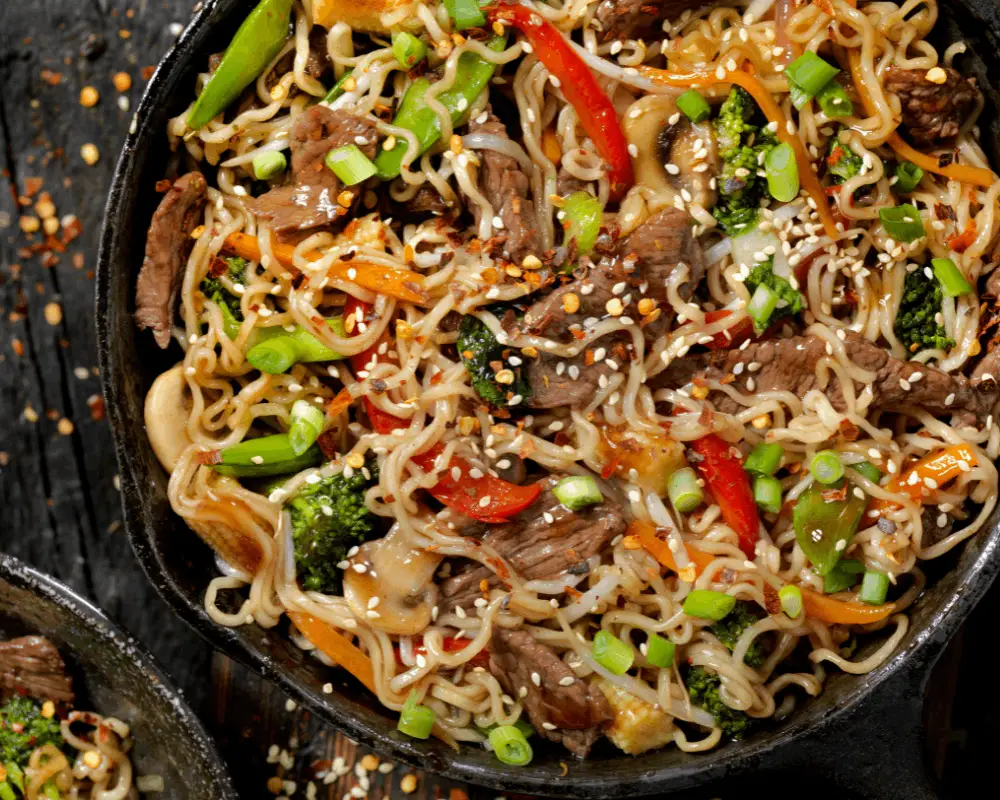Teriyaki beef ramen is a delicious meal that combines the rich umami flavors of tender meat, savory broth, and slurpable noodles. The combination of Chinese and Japanese flavors and textures has become incredibly popular throughout the world. In this article, we’ll look at the history of teriyaki beef ramen, its major ingredients, step-by-step cooking guide, variants, and adjustments, ideas for improving your bowl, its health advantages, and wrap up with some frequently asked questions.
The Origins of Teriyaki Beef Ramen
Ramen, a traditional noodle dish, has been a mainstay of Japanese cuisine for ages, and teriyaki beef ramen is a variation of that theme. Teriyaki beef ramen was created to add the flavors of teriyaki sauce, which is consisting of soy sauce, mirin, and sugar, to this well-known meal, whereas traditional ramen uses a broth prepared from a pig. This fusion shows off the inventiveness of culinary imagination and is now a favorite among food lovers around.
Understanding the Key Ingredients
To create a delicious bowl of teriyaki beef ramen, you’ll need the following key ingredients:
- Beef: For the greatest results, choose tender cuts of beef such as ribeye or sirloin.
- Ramen Noodles: Choose fresh or dried ramen noodles, which you can purchase from online or at Asian grocers.
- Broth: Traditional teriyaki beef ramen calls for a delicious beef broth enriched with soy sauce and other fragrant spices.
- Teriyaki Sauce: This savory and sweet sauce will give flavor and richness to this recipe. You can simply make your own Teriyaki Sauce, or use one from the store.
- Veggies: Adding a variety of veggies, like Chinese cabbage (Bok choy), mushrooms, bean sprouts, and Spring Onion to your ramen will make it more flavorful.
- Toppings: Toppings such as boiled eggs, nori seaweed, sesame seeds, and sliced green onions will add a touch of freshness and texture.
Step-by-Step Recipe Guide

1. Preparing the Broth
To create a flavorful broth for your teriyaki beef ramen, follow these steps:
- Heat a pot over medium heat and add one tablespoon of oil.
- Sauté diced onions, garlic, and ginger until fragrant.
- Add beef bones or beef stock and bring to a boil.
- Reduce the heat to low and let the broth simmer for at least two hours to develop its rich flavors.
- Strain the broth and remove any solids.
2. Marinating the Beef
For tender and flavorful beef, marinate it using the following steps:
- Slice the beef into thin strips against the grain.
- In a bowl, combine soy sauce, mirin, brown sugar, minced garlic, and grated ginger.
- Add the beef to the marinade and let it sit for at least 30 minutes.
- Heat a skillet over high heat and sear the beef until browned on the outside but still tender on the inside.
3. Cooking the Noodles
Cooking the ramen noodles requires the following simple steps:
- Bring a pot of water to a boil.
- Add the ramen noodles and cook according to the package instructions.
- Drain the noodles and rinse them under cold water to stop the cooking process.
4. Assembling the Ramen Bowl
Now comes the exciting part—putting together your teriyaki beef ramen bowl:
- Place the cooked ramen noodles in a serving bowl.
- Ladle the hot beef broth over the noodles.
- Arrange the marinated beef and vegetables on top.
- Drizzle teriyaki sauce over the bowl for added flavor.
- Garnish with your favorite toppings, such as soft-boiled eggs, nori seaweed, and sesame seeds.
Health Benefits of Teriyaki Beef Ramen
Teriyaki beef ramen, when prepared with nutritious ingredients, can offer several health benefits. Some of these include:
- Protein: Beef in teriyaki beef ramen provides a good source of protein, which is good for muscle growth and repair.
- Vegetables: Including a variety of vegetables in your ramen bowl adds essential vitamins, minerals, and dietary fiber to your meal.
- Noodles: Ramen noodles can be a source of carbohydrates for energy, especially when opting for whole wheat or buckwheat noodles.
- Broth: A well-made broth can be rich in collagen, gelatin, and amino acids that support joint health and improve digestion.








